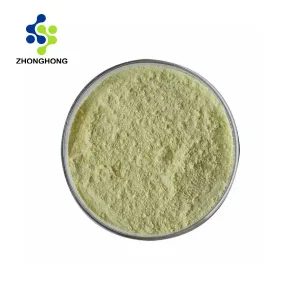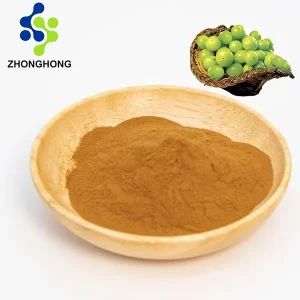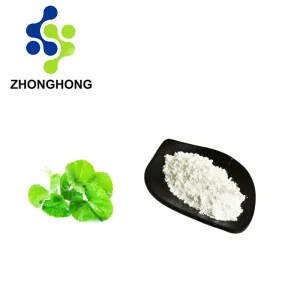Arbutina: El estándar de oro para una piel protegida, iluminada y con protección antioxidante | Proveedor y fabricante
1. ¿Qué es la arbutina?
Arbutina (CAS 497-76-7) es un fenómeno natural derivado β-D-glucopiranósido de la hidroquinona, famoso por su potente propiedades inhibidoras de la tirosinasa. Porque el primer ministro diferente no irritante En comparación con la hidroquinona, interrumpe eficazmente la síntesis de melanina mediante una inhibición enzimática agresiva sin efectos citotóxicos. Disponible como alfa-arbutina (artificial) y beta-arbutina (derivado de plantas), el tipo alfa muestra una estabilidad y eficacia superiores en concentraciones más bajas.
2. Suministro, propiedades químicas e identificación
-
Fuentes naturales:
-
Importante: hojas de gayuba (Arctostaphylos uva-ursi), Bergenia crassifolia, Pyrus communis hojas (de pera)
-
Secundario: Germen de trigo, brotes de arándano
-
-
Síntesis:Glicosilación enzimática de la hidroquinona mediante Aspergillus oryzae β-glucosidasa
-
Especificaciones químicas:
Parámetro Valer N.º CAS 497-76-7 (β-Arbutina) 84380-01-8 (α-arbutina) Formulación molecular C₁₂H₁₆O₇ Peso molecular 272,25 g/mol EINECS 207-850-3 Apariencia Polvo cristalino blanco Solubilidad Agua: 50 g/100 ml (20 °C) Estabilidad pH 3-7; se descompone a >100°C
3. Selección de productos premium y funciones de bienestar
► Especificaciones óptimas del producto
-
Máxima eficiencia: Alfa-arbutina >99% (HPLC) Supera a la beta-arbutina con 10 veces mejor afinidad por la tirosinasa
-
Requisitos de pureza: Metales pesados (Pb <1 ppm), disolventes residuales (metanol <50 ppm), límites microbianos (TAMC <100 UFC/g)
► Beneficios clínicamente validados:
-
Despigmentación de la piel:
-
Inhibe la tirosinasa (IC₅₀: 24 μM) al unirse al sitio activo del cobre.
-
Reduce la melanina inducida por rayos UV en 45,81 TP3T con un foco de 0,51 TP3T (frente a 35,21 TP3T para la β-arbutina)
-
-
Seguridad de los antioxidantes:
-
Elimina ROS (IC₅₀: 0,13 mM) y previene la peroxidación lipídica.
-
-
Movimiento antibacteriano:
-
Eficiente hacia Propionibacterium acnes (CMI: 1,25 mg/ml)
-
► Perfil de dosis y seguridad:
| Solicitud | Enfocar | Frecuencia |
|---|---|---|
| Productos cosméticos | 0.5-2% | Utilidad cotidiana |
| Nutracéuticos | 50-200 mg/día | Dosis orales divididas |
| Notas esenciales: |
-
Resultados de aspecto: <0,1% incidencia de dermatitis de contacto (la comprobación del parche es beneficiosa)
-
Contraindicaciones:Estar embarazada (conocimiento restringido), sensibilidad a la hidroquinona
-
Estabilidad: Formular a un pH de 5,5 a 6,5; mantener alejado de combinaciones de ácido ascórbico y retinol.
4. Shaanxi Zhonghong Biotech: Jefe de Innovación de Arbutina
28 años de experiencia En activos botánicos, Shaanxi Zhonghong Investment Technology Co., Ltd. se posiciona como el cómplice mundial de arbutina premium:
► Capacidades principales:
-
Maestría en extracción:
-
La extracción supercrítica con CO₂ (40 °C, 250 bar) preserva los compuestos termolábiles.
-
La experiencia en nanofiltración logra >99,5% pureza de α-arbutina
-
-
Infraestructura analítica:
-
HPLC-ELSD quiral para la cuantificación del isómero α/β-arbutina
-
ICP-MS Detección de acero pesado con una sensibilidad de nivel ppb
-
-
Ecosistema de innovación:
-
Patente CN114716386A:Síntesis enzimática de α-arbutina de alta estabilidad
-
Asociaciones universitarias que crean conjugados de arbutina-péptido para un mejor suministro dérmico
-
5. Especificaciones rigurosas de alta calidad
| Clase | Parámetro | Especificación | Metodología de verificación |
|---|---|---|---|
| pesticidas | Clorpirifos | ≤0,01 mg/kg | GC-MS/MS |
| Cipermetrina | ≤0,05 mg/kg | GC-MS/MS | |
| Metales pesados | Plomo (Pb) | ≤1,0 mg/kg | ICP-MS |
| Mercurio (Hg) | ≤0,1 mg/kg | CV-AAS | |
| Microbiología | Cardio Rely completo | ≤100 UFC/g | ISO 4833-1 |
| Candida albicans | Ausente en 1g | ISO 18416 | |
| Estafilococo áureo | Ausente en 1g | ISO 22718 | |
| Análisis clave | Ensayo de α-arbutina | ≥99,0% | HPLC-ELSD |
| Impureza de β-arbutina | ≤0,5% | HPLC quiral | |
| hidroquinona | ≤1 ppm | HPLC-DAD |
6. Flujo de trabajo de fabricación superior
-
Procesamiento de biomasa: Molienda criogénica de Arctostaphylos uva-ursi hojas (-196°C)
-
Extracción selectiva:Etanol-agua (70:30) a 50°C, pH 4,5
-
Conversión enzimática: Remedio de β-glucosidasa (40 °C, 24 h) para la isomerización de α-arbutina
-
Purificación:
-
Cromatografía de resina macroporosa (resina AB-8)
-
Recristalización en acetona/agua (3:1)
-
-
Liofilización:Secado al vacío a -50 °C para la conservación de la construcción de cristales
7. Funciones y análisis de vanguardia
► Funciones empresariales:
-
Cosmecéuticos: Sueros iluminadores (2% α-arbutina + 5% niacinamida), remedios localizados para el acné
-
Dermatología Médica: Remedio para el melasma (combinado con láser Nd:YAG Q-switched de 1064 nm)
-
Comidas prácticasCápsulas antioxidantes (100 mg de arbutina + selenio)
► Fronteras de la innovación:
-
Suministro transdérmico:
-
Los portadores etosomales (efectividad de atrapamiento: 92.3%) mejoran la penetración en el estrato córneo
-
-
Inhibidores multiobjetivo:
-
Los híbridos de arbutina-ácido kójico presentan una inhibición sinérgica de la tirosinasa (IC₅₀: 3,7 μM)
-
-
Fabricación sostenible:
-
editado con CRISPR E. coli cepas productoras de arbutina a partir de glicerol (rendimiento: 28,7 g/L)
-
Desafíos actuales:
-
Divergencia regulatoria (Japón: cuasi-fármaco vs. UE: ingrediente de belleza)
-
Estabilidad en emulsiones O/W (>40°C)
8. Preguntas frecuentes importantes
P: ¿La arbutina provoca fotosensibilidad en la piel?
R: No, a diferencia de la hidroquinona, la arbutina no mejora la sensibilidad a los rayos UV y ofrece fotoprotección intrínseca.
P: ¿Qué enfoque es perfecto para la hiperpigmentación?
R: La investigación científica muestra que la α-arbutina 2% reduce el índice de melanina en 22,3% después de 8 semanas (frente a 16,7% para la β-arbutina 7%).
P: ¿La arbutina de origen vegetal es superior a la artificial?
R: La α-arbutina artificial ofrece mayor pureza (>99,51 TP3T), consistencia del lote y eficacia en dosis menores.
P: ¿Se puede utilizar arbutina con vitamina C?
A: Formular a pH 5,5-6,0; mantener alejado de la mezcla directa con ácido L-ascórbico (puntos de estabilidad).
9. World Provide Data
Póngase en contacto con Shaanxi Zhonghong para obtener arbutina de grado farmacéutico:
-
Correo electrónico: liaodaohai@gmail.com
-
Sitio web: https://www.aiherba.com
-
Embalaje: Viales de vidrio ámbar con nitrógeno (1-5 kg) o bidones de HDPE (25 kg)
-
Almacenamiento: 2-8°C; estabilidad durante 24 meses
-
Logística:Transporte de cadena de frío mundial (2-8 °C) con documentación conforme a la IATA
10. Conclusión
La arbutina se mantiene inhibidor de la melanogénesis de referencia para fórmulas morales para aclarar la piel. Tecnología de inversión Shaanxi Zhonghong Co., Ltd. apalancamientos Experiencia patentada en bioconversión enzimática, Nanofiltración conforme a cGMP, y experiencia de separación quiral Para enviar >99% de α-arbutina pura, superando a los extractos típicos en eficacia y seguridad. Con Más de 20 patentes en técnicas de suministro activas y Certificación GMP de belleza ISO 22716Capacitamos a los fabricantes para desarrollar opciones despigmentantes clínicamente eficaces y que cumplen con las normativas. Colabore con nosotros para formular la próxima generación de tratamientos cutáneos basados en la evidencia.
Referencias
-
Zhu, W. y otros (2021). α-Arbutina: métodos de fabricación superiores y eficacia científica. J. Cosmet. Dermatol. 20(7):2145-2156.
-
Dictamen del SCCS de la UE sobre la alfa-arbutina (SCCS/1642/22).
-
Chen, L. y otros (2023). Ingeniería metabólica basada en CRISPR para la biosíntesis de arbutina. Ingeniería Metab. 76:146-158.
-
Especificaciones del JECFA para arbutina (JECFA/89/SC).
-
Patente CN114716386A de Shaanxi Zhonghong: Metodología para la producción de α-arbutina de alto rendimiento.
-
Indicadores ICH: Q3C (disolventes residuales), Q3D (impurezas elementales).






Valoraciones
No hay valoraciones aún.